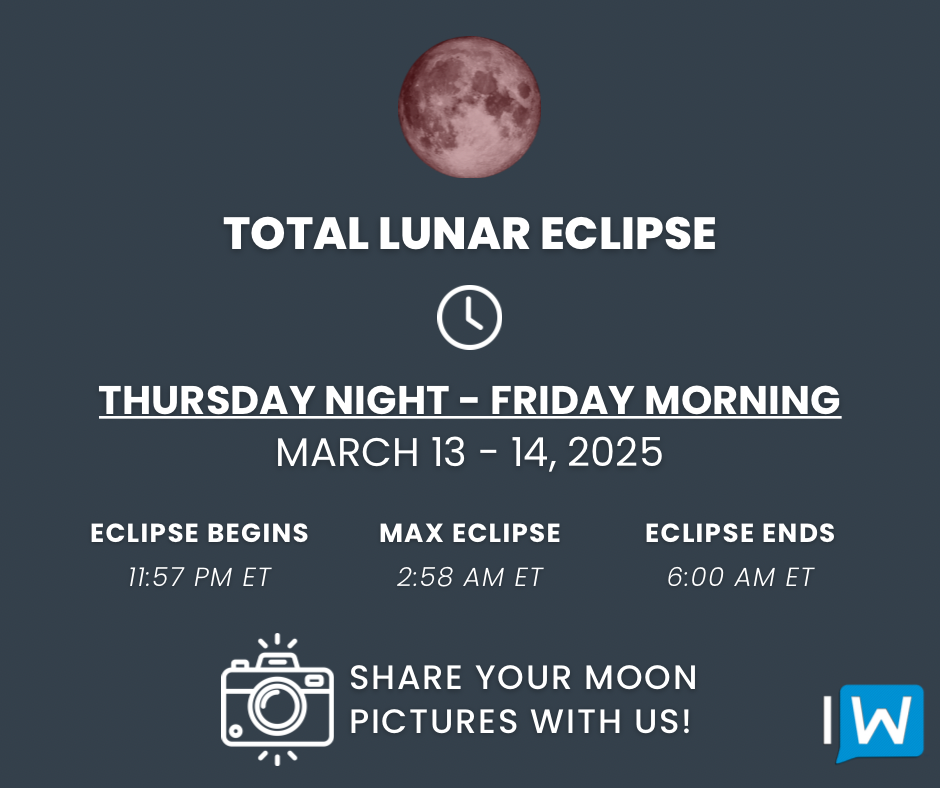Second Solar Eclipse in as Many Years Might Peak Through the Clouds in the Maritimes Early Saturday
/Those in the Maritimes who witnessed last spring’s solar eclipse, and even those who didn’t, might be lucky enough to catch a glimpse of a partial eclipse as the Sun rises on Saturday, March 29th. The eclipse will actually begin before the sunrise and the Sun will already be partially covered as it begins to rise, so a clear view of the eastern horizon will be necessary.
The odds of the eclipse being visible, though, will be dependent on whether the clouds cooperate and we get some clear skies Saturday morning. Unfortunately, the eclipse will likely not be visible for most of the region due to cloud cover ahead of snow moving in from the west later in the day.
Timing and Coverage
While parts of the New Brunswick and Prince Edward Island experienced totality in 2024, that will not be the case this time around. The good news, however, is that the entire region will still significant sun coverage in the 80%-90% range so that if the eclipse ends up being visible in your area, you’ll be in for a treat!
Solar Eclipse Timing Across New Brunswick
| Location |
Max Coverage |
Sunrise |
Maximum |
Partial Ends |
|---|---|---|---|---|
| Bathurst |
86.15% |
7:06 AM |
7:22 AM |
8:18 AM |
Edmundston |
86.10% |
7:17 AM |
7:22 AM |
8:17 AM |
| Fredericton |
84.56% |
7:11 AM |
7:19 AM |
8:14 AM |
| Miramichi |
85.56% |
7:06 AM |
7:21 AM |
8:17 AM |
| Moncton |
84.53% |
7:04 AM |
7:19 AM |
8:15 AM |
| Saint John |
83.76% |
7:09 AM |
7:18 PM |
8:13 AM |
Solar Eclipse Timing Across Nova Scotia
| Location |
Max Coverage |
Sunrise |
Maximum |
Partial Ends |
|---|---|---|---|---|
| Amherst |
84.20% |
7:02 AM |
7:19 AM |
8:15 AM |
Antigonish |
83.63% |
6:53 AM |
7:19 AM |
8:15 AM |
| Bridgewater |
82.61% |
7:04 AM |
7:17 AM |
8:12 AM |
| Halifax |
82.82% |
7:00 AM |
7:17 AM |
8:13 AM |
| Kentville |
83.40% |
7:03 AM |
7:18 AM |
8:13 AM |
| New Glasgow |
83.71% |
6:56 AM |
7:19 PM |
8:15 AM |
| Sydney |
83.79% |
6:46 AM |
7:20 PM |
8:16 AM |
| Truro |
83.58% |
6:59 AM |
7:18 PM |
8:14 AM |
| Yarmouth |
82.11% |
7:10 AM |
7:16 PM |
8:11 AM |
Solar Eclipse Timing Across Prince Edward Island
| Location |
Max Coverage |
Sunrise |
Maximum |
Partial Ends |
|---|---|---|---|---|
| Alberton |
85.19% |
7:00 AM |
7:21 AM |
8:17 AM |
Charlottetown |
84.43% |
6:57 AM |
7:20 AM |
8:16 AM |
| Kensington |
84.76% |
6:59 AM |
7:20 AM |
8:16 AM |
| Montague |
84.33% |
6:55 AM |
7:19 AM |
8:16 AM |
| Souris |
84.44% |
6:53 AM |
7:20 PM |
8:16 AM |
| Summerside |
84.70% |
7:00 AM |
7:20 PM |
8:16 AM |
For specific eclipse coverage and timing in your location, you can go to timeanddate.com to find detailed information.
Safety Measures
Safety is paramount when viewing any solar eclipse, even a partial one. To ensure a safe and memorable experience, follow these crucial precautions:
Solar Viewing Glasses: Never attempt to observe the eclipse with the naked eye. Only use certified solar viewing glasses or eclipse glasses with ISO 12312-2 certification, specifically designed to protect your eyes from the Sun's harmful radiation.
Pinhole Projection: If eclipse glasses are unavailable, create a pinhole projector using common materials like cardboard. This indirect method allows you to project the eclipse safely onto a surface for viewing.
Telescopes and Binoculars: If using telescopes or binoculars, ensure they are equipped with proper solar filters to safeguard your eyes. Never aim them directly at the Sun without these protective measures.
Online Streaming: For those unable to view the eclipse in person or seeking a risk-free option, numerous reputable sources will provide live streaming of the event.
Local Eclipse Events: Consider joining local astronomy clubs or observatories hosting eclipse-viewing gatherings. These events offer expert guidance and a shared sense of community.
We’re going to continue to keep an eye on the cloud cover situation for Saturday over the coming days and will post any updates.










